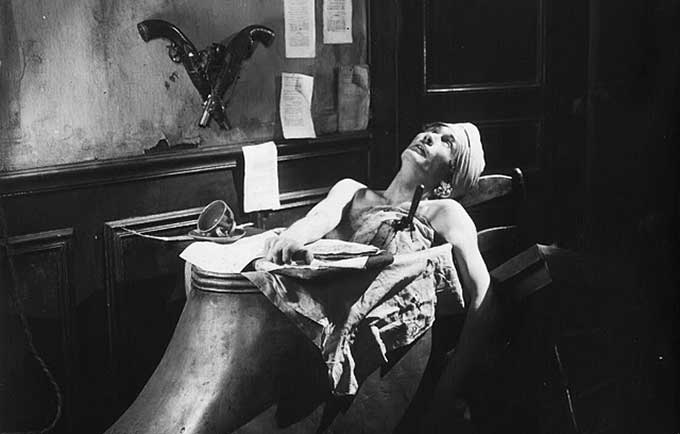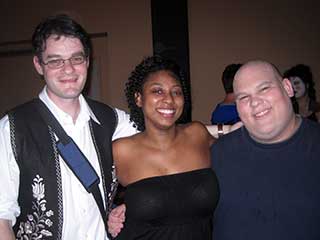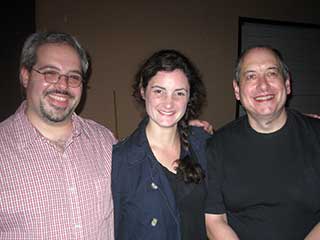Marat/Sade at Subversive Theatre
by Anthony Chase

Marat/Sade
A play within a play, Peter Weiss’s Marat/Sade tells the story of the 1793 murder of Jean-Paul Marat by Charlotte Corday during the French revolution. The tale is acted out by mental patients in Charenton Asylum as part of their therapy in a production supervised by the hospital’s chief administrator, Coulmier, and directed by the Marquis de Sade—yes, the same marquis whose name gives us the word “sadism.” DeSade actually was confined to the historic asylum and actually did stage performances there. Indeed, the complete (but seldom used) title of Weiss’ play is The Persecution and Assassination of Jean-Paul Marat as Performed by the Inmates of the Asylum of Charenton Under the Direction of the Marquis de Sade.
As the play begins, the year is 1808, and Coulmier expects that the performance will be a patriotic celebration of the ideals of Napoleon’s post-revolutionary government. He finds, instead, that the subversive minds of the inmates are uncontrollable. Fifteen years after the revolution, the actors clearly realize that they are no better off than they were before.
Ever since Peter Brook’s landmark production of the play as part of the Royal Shakespeare Company’s famed 1964 “Theater of Cruelty Season,” every generation has wanted to rediscover Marat/Sade. Typically, these remounts occur on university campuses, where the script provides a convenient vehicle for acting students to cavort as if they were crazy.
Next month, as part of their 50th anniversary season, the Royal Shakespeare Company will open a new production of Marat/Sade. There are those who have trepidation about this, fearful that a new production of a seminal work will invite unflattering comparison, or that so many years later, the piece will have lost its subversive edge.
I experienced a certain amount of trepidation myself, going into the Subversive Theatre production, directed by Kurt Schneiderman and featuring Christopher Standart as the Marquis deSade, Lisa Vitrano as Charlotte Corday, Kevin Iuzzini as Marat, and Becky Globus serving as mistress of ceremonies in the role of the herald. “Am I about to be accosted by actors in clown makeup as I enter an environmental setting?” I thought. Quickly, I answered my own question, “Of course I am!”
Opening Shots
Marat/Sade, Subversive Theatre Collective at the Manny Fried Playhouse



Top: Christopher Standart, who plays the Marquis de Sade, with Lisa Vitrano, who plays Charlotte Corday, and Kevin Iuzzini, who plays Marat. Middle: Music director Moshe Shulman with cast members India Moss and Leo DiBello. Bottom: Director Kurt Schneiderman with cast members Becky Globus and Lawrence Roswell.
I bolstered myself for the inevitable, and shouldered on.
The Subversive production, staged with a game and able cast, is an homage to productions past. Yes, it is an environmental staging; yes, we see ensemble members in white face, and the theatrical approximation of bedlam; yes, actors interact with the audience throughout. So firmly and decisively did Peter Brook place his imprint on Marat/Sade that his name is more closely associated with the piece than that of its author. The clown-white faces of the ensemble harked back to Jean Genet’s The Blacks: A Clown Show (1959) and anticipated the same look, used to decidedly more benign and mainstream effect, in Godspell (1971)—a play that was tellingly pioneered on a university campus. In time, what was revolutionary becomes old hat.
At the same time, every return to Weiss’s text invites an exploration of the theatrical practices of Bertolt Brecht and Antonin Artaud that inspired it. The melding of Brecht’s political voice with Artaud’s “Theater of Cruelty” is an enticing recipe for an evening of playful subversion and pointed commentary.
It is fascinating to know that the Marat story provided specific fascination for Artaud personally. In the days before every filmic moment was instantly available on the internet, I remember going to Shea’s Buffalo and watching in hushed awe as Artaud himself appeared on screen as Marat in Abel Gance’s 1927 silent epic, Napoleon. Before then, I had only seen still photographs of the brilliant author of Theater and Its Double as a wizened and drug-addicted old man. The vision of his stark and beautiful face, as he assumed the bathtub pose familiar from Jacques Louis David’s 1793 neo-classical painting, The Death of Marat, was simultaneously iconic and iconoclastic.
This is, of course, the central image of Marat/Sade as well.
Brook’s famed staging, second in his career only to his groundbreaking vision for Shakespeare’s A Midsummer Night’s Dream set in a circus milieu, made a star of young Glenda Jackson, who reprised her London performance as Charlotte Corday on Broadway. London’s original Marat, Clive Revill, had already played Fagin on Broadway in Oliver! and was replaced by Ian Richardson (the herald in the Royal Shakespeare Company’s original Marat/Sade), who thereby became the first actor to appear nude on a Broadway stage.
Kevin Iuzzini is afforded considerably more modesty in his performance as Marat at the Manny Fried Playhouse. This is not to say that the production is staged with a prudish eye. Michael Votta, as the asylum’s most sexually aggressive inmate, appears entirely disrobed in the play’s final moments, and there are tarts aplenty, as the script requires. One did not need to be mentally ill to be sent to the asylum in 1808—only to be sufficiently anti-social to irritate those in power. The “madness” depicted in Marat/Sade is more metaphorical than literal.
The performances in the central roles are quite powerful. In addition to Iuzzini’s affecting performance as the doomed Marat, Becky Globus gives an engaging and well-articulated performance as the herald; and Lisa Vitrano plays the murderous Charlotte Corday with delightfully casual indifference. Christopher Standart brings his wry sense of humor and commanding stage presence to the Marquis de Sade wickedly yet enjoyably. Mr. Votta is charmingly comical as the loathsome Duperret, who lusts for disinterested Corday. Lawrence Rowswell is full of bourgeois bluster as Coulmier. Leo DiBello creates a real and stable presence as Marat’s protective attendant, Simonne. Scot Kaitanowski assays the role of Jacques Roux, the willfully vocal cleric with authority and conviction. Elexa Kopty, Justin Krall, Candace M. Whitfield, and Emily Pedersen cheerfully and acrobatically gambol about the scene and keep the action moving as a quartette of mimes.
Lighting design is by Katie Gilliland, with scenery by Michael Lodick, and costumes by Max Levitt. Monica Karwan has choreographed the movement with fight choreography by Justin Krall. The original score and highly entertaining live instrumental performance by amiable Moshe Shulman, who performs in full view of the audience, adds tremendously to the production.
|
Issue Navigation> Issue Index > v10n38 (Fall Food Issue, week of Thursday, September 22) > Theater Week > Marat/Sade at Subversive Theatre This Week's Issue • Artvoice Daily • Artvoice TV • Events Calendar • Classifieds |









 Current Issue
Current Issue